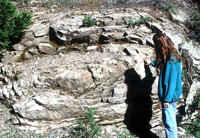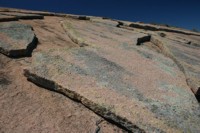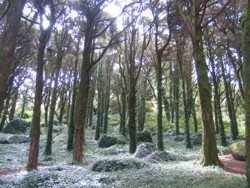
From the guidelines, as from January 2013"People do not need to wait for permission to log your EarthCache. Requiring someone to wait is not supported by the EarthCache guidelines. People should send their logging task answers to you, then log your EarthCache. When you review their logging task answers, if there is a problem, you should contact them to resolve it. If there is no problem, then their log simply stands."

What is Weathering?
Weathering causes the disintegration of rock near the surface of the earth. Plant and animal life, atmosphere and water are the major causes of weathering. Weathering breaks down and loosens the surface minerals of rock so they can be transported away by agents of erosion such as water, wind and ice. There are two types of weathering: mechanical and chemical.
Mechanical Weathering
Mechanical weathering is the disintegration of rock into smaller and smaller fragments. Frost action is an effective form of mechanical weathering. When water trickles down into fractures and pores of rock, then freezes, its volume increases by almost 10 percent. This causes outward pressure of about 2700 kg per square cm at -22 ºC. Frost action causes rocks to be broken apart into angular fragments. Extreme temperature range in the high country causes frost action to be a very important form of weathering.
Exfoliation is a form of mechanical weathering in which curved plates of rock are stripped from rock below. This results in exfoliation domes or dome-like hills and rounded boulders. Exfoliation domes occur along planes of parting called joints, which are curved more or less parallel to the surface. These joints are several inches apart near the surface but increase in distance to several feet apart with depth. One after another these layers are spalled off resulting in rounded or dome-shaped rock forms. Most people believe exfoliation is caused by instability as a result of drastically reduced pressure at the earth's surface allowing the rock to expand.
Exfoliation domes are best developed in granitic rock.
Another type of exfoliation occurs where boulders are spheroidally weathered. These boulders are rounded by concentric shells of rock spalling off, similar to the way shells may be removed from an onion. The outer shells are formed by chemical weathering of certain minerals to a product with a greater volume than the original material. For example, feldspar in granite is converted to clay which occupies a larger volume. Igneous rocks are very susceptible to mechanical weathering.
Chemical Weathering
Chemical weathering transforms the original material into a substance with a different composition and different physical characteristics. The new substance is typically much softer and more susceptible to agents of erosion than the original material. The rate of chemical weathering is greatly accelerated by the presence of warm temperatures and moisture. Also, some minerals are more vulnerable to chemical weathering than others. For example, feldspar is far more reactive than quartz.
Differential weathering occurs when some parts of a rock weather at different rates than others. Excellent examples of differential weathering occur in the Idavada silicic volcanic rocks in the Snake River Plains. Balanced Rock and the Gooding City of Rocks are outstanding examples of differential weathering.
 Claiming the earthcache
Claiming the earthcache
The above coordinates will take you to the Sintra Mountains near the Peninha monastery where you are confronted with an outcrop of granite that exemplifies very clearly the effects of mechanical weathering. You will observe a perfect example of exfoliation/Spheroidal weathering and I want you to tell me how many exfoliation scales are present at the top of this outrcrop. Send me your answers via e-mail through my GC profile to validate your found.
Note: NO photos that will give away the answer. Tell-tale photos = log deletion.

O que é erosão?
A Erosão é a destruição da rocha à superfície da terra (e do solo também) e seu transporte em geral feito pela água da chuva, pelo vento ou, ainda, pela acção do gelo, quando este actua expandindo o material no qual se infiltra a água congelada. A erosão destrói as estruturas (areias, argilas, óxidos e húmus) que compõem o solo. Estas são transportados para as partes mais baixas dos relevos e em geral vão assorear cursos de água. (vêr LINK).
 Erosão física ou mecânica
Erosão física ou mecânica
Conduzem à desagregação da rocha, sem que haja necessariamente uma alteração química maior dos minerais constituintes. Os principais agentes de erosão física são variação de temperatura, cristalização de sais, congelamento da água e actividades de seres vivos.
Variação da temperatura - Com o aumento da temperatura os minerais sofrem dilatação, desenvolvendo pressões internas que desagregam os minerais e desenvolvem microfraturas, por onde penetrarão a água, sais e raízes vegetais.
Cristalização de sais - O sal trazido pela maresia, se cristaliza nas fraturas, desenvolvendo pressões que ampliam efeito desagregador.
Atividades biológicas (biomecânicos) -: as raízes de árvores podem trabalhar como agentes intempéricos. Elas actuam como forma motriz para abrir canais para que outros agentes intempéricos actuem nas rochas e minerais.
Exfoliação e disjunção esferoidal - Duas formas de fragmentação rochosa não relacionadas directamente a fracturas preexistentes são a exfoliação e a disjunção esferoidal. A exfoliação é um processo de meteorização física pelo qual placas grandes e achatadas ou curvas de rocha  são fracturadas e destacadas de um afloramento. A disjunção esferoidal consiste, também, na fragmentação e separação de camadas curvas de um bloco geralmente esférico mas, usualmente, numa escala muito menor. O seu mecanismo permanece desconhecido mas pode resultar de fendas paralelas à superfície do afloramento causadas por alteração química ou da distribuição diferencial de meteorização química e mudanças de temperatura.
são fracturadas e destacadas de um afloramento. A disjunção esferoidal consiste, também, na fragmentação e separação de camadas curvas de um bloco geralmente esférico mas, usualmente, numa escala muito menor. O seu mecanismo permanece desconhecido mas pode resultar de fendas paralelas à superfície do afloramento causadas por alteração química ou da distribuição diferencial de meteorização química e mudanças de temperatura.
Erosão química
Implica em transformações químicas dos minerais que compõem a rocha. O principal agente da erosão química é a água. Os feldspatos e micas são transformados em argilas, ao passo que o quartzo permanece inalterado. Os principais mecanismos da erosão química são: oxidação, dissolução, hidrólise, hidratação e carbonatação.
A acção das soluções aquosas sobre o feldspato e sobre a mica biotite, leva à produção de argilas e à formação do solo. A principal argila formada é o caulino, que é branco quando puro, o que o acontece muito raramente. A cor vermelha do solo se deve aos óxidos de Ferro e Manganês liberados pela alteração da biotite e outros minerais que possuem estes elementos químicos em sua fórmula.
Na superfície, o solo é mais rico em argila e matéria orgânica. A medida que se aprofunda aumenta o número de cristais de feldspato, os quais já se encontram em processo de desagregação e de alteração química.
A earthcache
Para fazeres este found, dirige-te às coordenadas indicadas no topo da página que te levam a um afloramento granítico no parque de merendas da Peninha. Aqui observa com atenção o afloramento à tua frente que exemplifica os processos be Exfoliação e/ou Disjunção Esferoidal (é simplesmente uma questão de escala) e diz-me quantas camadas de exfoliação estão presentes em cima do afloramento. Manda-me um mail através do meu profile do GC.com para validar o "found".
Nota: Logs com fotos que mostrem a resposta serão implacavelmente APAGADOS.
Happy earthcaching!
 The most exciting way to learn about the Earth and its processes is to get into the outdoors and experience it first-hand. Visiting an Earthcache is a great outdoor activity the whole family can enjoy. An Earthcache is a special place that people can visit to learn about a unique geoscience feature or aspect of our Earth. Earthcaches include a set of educational notes and the details about where to find the location (latitude and longitude). Visitors to Earthcaches can see how our planet has been shaped by geological processes, how we manage the resources and how scientists gather evidence to learn about the Earth. To find out more click HERE.
The most exciting way to learn about the Earth and its processes is to get into the outdoors and experience it first-hand. Visiting an Earthcache is a great outdoor activity the whole family can enjoy. An Earthcache is a special place that people can visit to learn about a unique geoscience feature or aspect of our Earth. Earthcaches include a set of educational notes and the details about where to find the location (latitude and longitude). Visitors to Earthcaches can see how our planet has been shaped by geological processes, how we manage the resources and how scientists gather evidence to learn about the Earth. To find out more click HERE.

